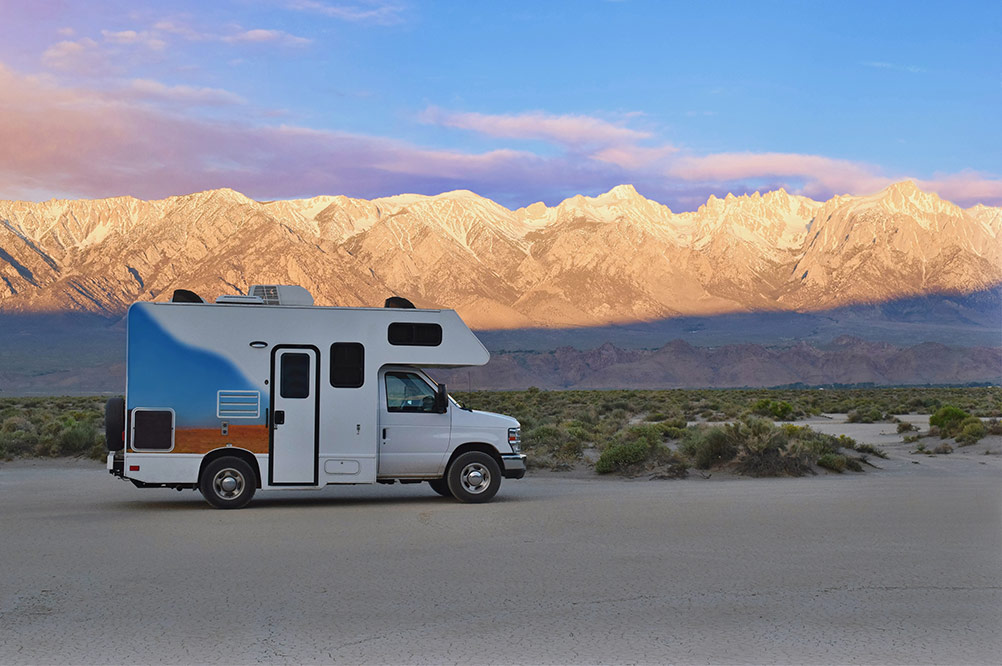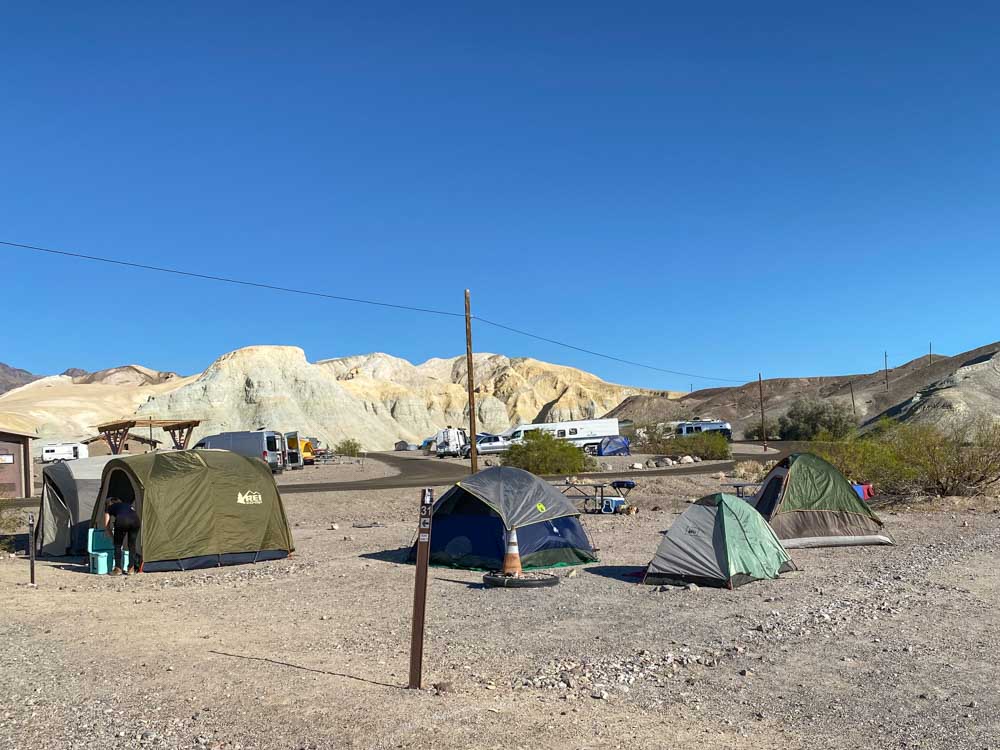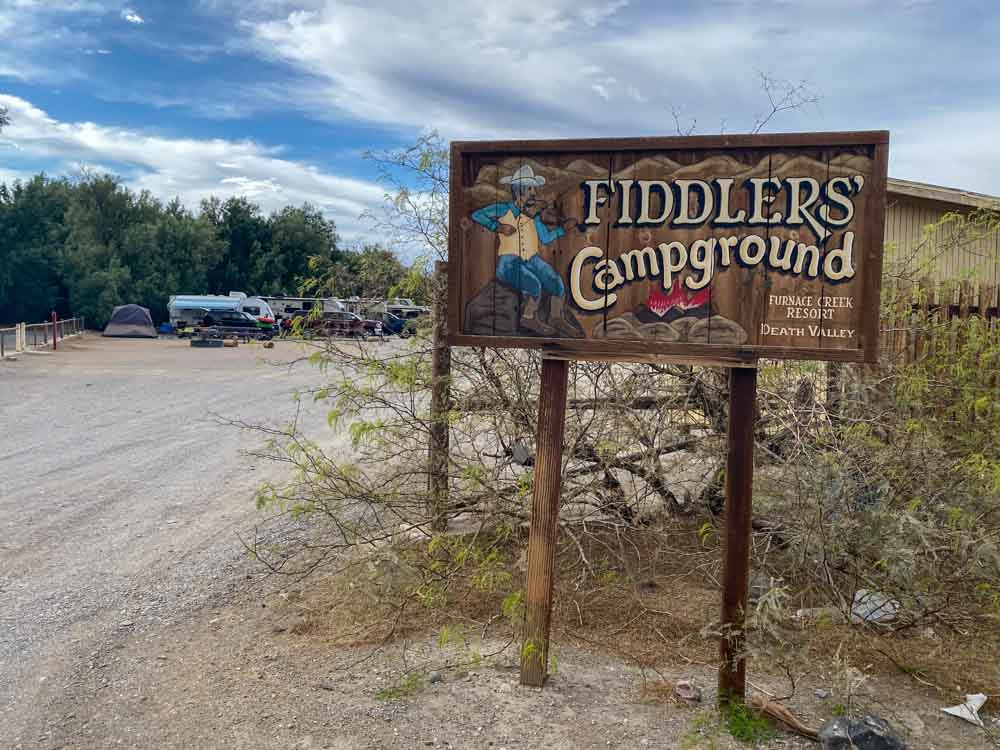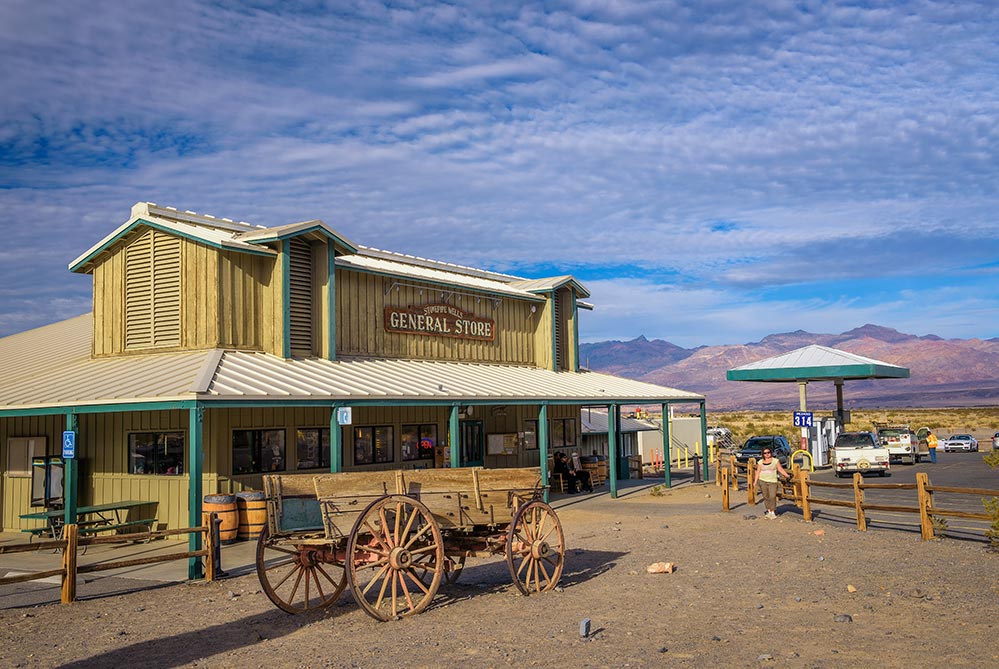There are 12 private and public campgrounds in Death Valley, disbursed across the 5,200 square miles of the National Park. They are on the valley floor, up in the mountains, on accessible roads and also out in the boonies.
This guide covers all of them, giving you suggestions for how to find the best Death Valley campground to suit your needs and itinerary.

Planning Your Death Valley Camping Trip
Because Death Valley is so large, you’ll want to think carefully about how to plan your trip so that you can maximize the time that you have there. You’ll want to consider how many days to alot to the the park, what time of year to go and what sorts of activities you want to engage in while there. Here are our suggestions for how to put together an epic Death Valley camping trip:
Get the Death Valley Vacation Guide: It’s got the full scoop for planning your Death Valley Trip.
Death Valley Itinerary Suggestions
Start by checking out our 2-day Death Valley itinerary. It covers the most popular park highlights, like Zabriskie Point, Mesquite Dunes, Rhyolite ghost town, Badwater Basin and Artist Palette drive.
If you are planning to zoom into the park, spend just one night and then zoom out, then use our 1-day Death Valley itinerary. It has several options for coming into the park from both the north and south, offers directions from Las Vegas and gives options for sunset views.
If you are also planning to visit the Eastern Sierras, check out our Highway 395 road trip guide. We also offer a loop route from SF to Death Valley. Or if you are doing a National Parks loop, check out our Joshua Tree itinerary, and our Joshua Tree camping guide.
Learn More About Death Valley Before You Go
Did you know that Scotty didn’t even own Scotty’s Castle? Or that Death Valley is one of the hottest places on earth (especially in the summer)? Or that a half-blind mule helped to guide lost and exhausted pioneers out Death Valley in 1849?
These are just but a few of the fun facts about Death Valley that you can read up on before you go.
Best Time of Year for Camping in Death Valley
That hottest place on earth thing…it’s real. From May to September daytime highs often exceed 100’F and the evenings don’t cool off much. In April of 2020, they recorded a blistering 130’F in the park! For this reason, Death Valley is best visited from October to April. In fact, some of the public Death Valley campgrounds in the lower elevations are only open from mid-October to mid-April. Although, the private campgrounds tend to stay open all year.
That said, there are some higher elevation campgrounds in Death Valley that are suitable (and even preferable) for cooler weather camping. These include: Wildrose, Thorndike, Mahogany Flat and Mesquite Spring. More info on them below so keep scrolling.
Can You Have a Campfire in Death Valley?
Most of the Death Valley campgrounds and RV spots have fire pits. Some are individual to the campsite and others are communal. However, this is the desert after all and you won’t be able to forage for wood and kindling. You can sometimes buy wood at the Stovepipe Wells store, but it would be wise to bring some wood with you.

Find the Best Death Valley Campground for You
Central Core Campgrounds
If you are planning to do the top park sites, then your best Death Valley campground will be one of the four that are located in the park’s central core near Furnace Creek. From there, it’s an easy drive to Zabriskie Point, Artist’s Palette Way, Badwater Basin, Dante’s Peak, the Golden Canyon trail and the Sidewinder Canyon trail.
Furnace Creek Campground
Furnace Creek is arguably the best campground in Death Valley. It has nice spacious camp spots with fire pits and picnic tables for each. There are quite a few trees around the perimeter of the site, which offer shade to those lucky enough to snag those spots.
This is an extremely popular campground and the reservations book up six months in advance during the October-April high season. But between mid-April and mid-October, no reservations are required.
- # of sites: 150
- Hook ups/dump site: Only 18 sites have hook-ups, the rest are dry camping. There is a dump site and fresh water refill across from the Visitor’s Center.
- Campsite type: Car camping/Tent/RV
- Water/toilets/showers: Yes/Flush/No
- Fees: $22 standard (or $11 for seniors). $36 hook-ups (or $25 for seniors)
- When open: Year round
Texas Spring
If you can’t swing a reservation at Furnace Creek, then Texas Spring is the second best Death Valley campground option. It’s located just a few minutes east of Furnace Creek. It’s a first come, first served (FF) campground so get there as early so you can to score a good spot.
Texas Spring campground is nice because it also has some shady spots on the south end as well as picnic tables and fire pits for individual sites.
- # of sites: 115
- Hook ups/dump site: No/Yes
- Campsite type: Car camping/Tent/RV (but no generator use allowed)
- Water/toilets/showers: Yes/Flush/No
- Fees: $16 standard (or $8 for seniors)
- When open: mid-Oct to mid-April

Sunset Campground
Sunset isn’t the fanciest Death Valley campground, but it will do. It functions as Death Valley’s overflow lot and is basically an extra large dirt expanse with camp spots marked out. There is no shade or picnic tables and only group fire pits. This makes Sunset better for RVers than tent campers, but both can use the campground. Sunset very rarely fills up, so even if you get in late on a Friday, you can still probably get a spot there.
If you are looking for this campground on the reservation website, you won’t find it. It’s an FF campground, so just show up.
- # of sites: 270
- Hook ups/dump site: No/Yes
- Campsite type: Car camping/Tent/RV
- Water/toilets/showers: Yes/Flush/No
- Fees: $14 standard (or $7 for seniors)
- When open: mid-Oct to mid-April

Fiddler’s Camp
This private campground is owned by Oasis Death Valley. They own the Oasis Resort and The Ranch at Furnace Creek, which is located right next door to the campground. Frankly, this campground is no great shakes. It’s a dirt lot like Sunset, they have don’t have picnic tables and only communal fire pits. It also costs 2x the price of the National Park campgrounds.
That said, Fiddler’s Camp can be worth it if you want to use the resort amenities. These include a pool, wifi, a laundry room, tennis court, shuffleboard, volleyball, bocce ball and basketball court.
- # of sites: 31
- Hook ups/dump site: No/No (but you can use the Parks dump site and water across the street)
- Campsite type: Car camping/Tent/RV
- Water/toilets/showers: Yes/Flush/No
- Fees: $29 weekday, $34 weekend
- When open: Year round

Northern Death Valley Campground- Mesquite Springs
The northern part of Death Valley is a great place for camping if you are looking for some space from the crowds. Mesquite Springs is near Scotty’s Castle (which is still closed) and also the Ubehebe Crater. Because there is no development nearby, it’s a great spot for stargazing. But it’s a long drive from Mesquite to the popular Furnace Creek sights and hikes.
The campground sits at 1,800 feet so it’s higher than the central sites and will be cooler in the summer. Mesquite Springs offers fire pits but no picnic tables.
- # of sites: 40
- Hook ups/dump site: No/Yes
- Campsite type: Car camping/Tent/RV
- Water/toilets/showers: Yes/Flush/No
- Fees: $14 (or $7 for seniors)
- When open: Year round

Western Death Valley Campgrounds
The campgrounds in western Death Valley offer access to the Mesquite Dunes, Emigrant Canyon and Charcoal Kilns. Slightly further away are the Darwin and Ballarat ghost towns, both of which make our list of the coolest ghost towns in Death Valley.
Stovepipe Wells RV Park
This privately owned RV park is run by the Stovepipe Wells village. They offer the rare hook-up and an opportunity to load up with a resupply at their store. A RV spot includes access to their pool and wifi. The pool is fine, the wifi is iffy. Make reservations at Death Valley Hotels.
- # of sites: 14
- Hook ups/dump site: Yes/Yes
- Campsite type: RV
- Water/toilets/showers: Yes/Flush/Yes
- Fees: $40
- When open: Year round
Stovepipe Wells Parks Service Campground
The Stovepipe Wells public campground is a basic, dirt lot with no shade. That said, for a nominal fee, you can use the pool and showers at Stovepipe Wells hotel. It’s a decent option if you are rolling in late from Highway 395 or if you want to do sunrise at nearby Mesquite Dunes. There are some fire pits and tables, but not at all sites. Stovepipe Wells is an FF campground.
- # of sites: 190
- Hook ups/dump site: No/Yes
- Campsite type: Car camping/Tent/RV
- Water/toilets/showers: Yes/Flush/Yes (for a fee)
- Fees: $14 ($7 for seniors)
- When open: mid-Sept to mid-May
Emigrant Campground
This small FF campground by the side of the road is convenient if you are rolling in late from Panamint Valley or Hwy 395. It also offers very easy access to Emigrant Canyon road. The campsite itself is free and very bare bones. Emigrant campground is located at 2,100 feet so it’s a bit cooler than central Death Valley. The site is supposed to be tent-only but you can probably get away with a smaller class B van.
- # of sites: 10
- Hook ups/dump site: No/No
- Campsite type: Car camping/Tent/Van(?)
- Water/toilets/showers: Yes/Flush/No
- Fees: Free
- When open: All year
Wildrose Campground
Wildrose is located ~20 miles into Emigrant Canyon. The campsite is at 4,100 feet, so expect nice daytime temperatures but cooler nights. The scenic road into the canyon is narrow with a lot of turns and not many guardrails. So, gird your loins and don’t drive in with an RV over 25 feet. Like Emigrant, the Wildrose campground is FF and free, so it makes a nice choice for the budget road tripper.
- # of sites: 23
- Hook ups/dump site: No/No
- Campsite type: Car camping/Tent/RVs under 25 feet
- Water/toilets/showers: Yes/Vault/No
- Fees: Free
- When open: All year (weather permitting)
Thorndike Campground
Thorndike goes up even higher into the canyon and at 7,400 feet, it’s definitely not a winter campground. The Parks Service recommends 4×4 with clearance to get into the campsite and nearby Charcoal Kilns. Thorndike has sandy camp sites and is good for stargazing and epic views.
- # of sites: 6
- Hook ups/dump site: No/No
- Campsite type: 4×4 camping/Tent
- Water/toilets/showers: No/Vault/No
- Fees: Free
- When open: Closed during the winter
Mahogany Flat
Climb another 1,000 feet above Throndike Campground and you’ll find one of the few shady campgrounds in Death Valley. Mahogany sits amidst the juniper pine trees and has jaw dropping views of the Death Valley Basin.
- # of sites: 10
- Hook ups/dump site: No/No
- Campsite type: 4×4 camping/Tent
- Water/toilets/showers: No/Vault/No
- Fees: Free
- When open: Closed during the winter
Panamint Springs
Panamint Springs is a rustic resort located at the far western edge of Death Valley. They bill themselves as “historic” and they have some kitsch to spare. It’s a good overnight on your way in/out of the park from either Hwy 395 or the Panamint Valley. In addition to the camping, they have a restaurant, hotel, bar, gas and a store.
- # of sites: 54
- Hook ups/dump site: Yes/Yes
- Campsite type: 6 Full-hookup Sites, 26 Dry Sites, 22 Tent Sites, Small and Large Tent Cabins.
- Water/toilets/showers: Yes/Yes/Yes
- Fees: $15 tents/$30 dry RV sites/$60 full hook-up
- When open: Year round

(This article contains affiliate links. This means that if you choose to purchase, I’ll make a small commission.)
2 Insanely Useful Pieces of Camping Gear that You Should Buy Now
- A folding table: Because so many of these campgrounds don’t have tables, you’ll need something to bring your own. We recently got the Mountain Summit Gear table and are loving it. It’s perfect for two people and will hold dinner plates, cocktails and morning coffee. It’s got an ingenious design, which is a little tricky to figure out at first, but it folds up neatly into a very small bag.
- Compression dry bags. Even if you are camping in an RV (or in our case a van), space is at a premium. We use the Sea to Summit compression drybags every time we travel, whether it’s for camping or going to Europe. They are much better than packing cubes at sorting and compressing soft goods and clothes.
“For this is the real nature of California and the secret of its fascination; this untamed, undomesticated, aloof, prehistoric landscape which relentlessly reminds the traveller of his human condition and the circumstances of his tenure upon the earth. —
-Christopher Isherwood
True that Chris. Death Valley’s desert landscape is relentless and untamed. But it doesn’t have to remain aloof, particularly if you go camping in it. Enjoy your trip and happy trails!
More CA Campground Guides
- Complete guide for camping in Big Sur.
- Joshua Tree campground guide.
- State park guides for: Salt Point State Park, Pismo State Beach, Hendy Woods State Park, Van Damme State Park, Malakoff Diggins and Half Moon Bay Francis Beach.
Share the best Death Valley campgrounds with your friends on Pinterest:



My family’s planning to set out a camp in the next two weeks…this is just so timely to read.
I use Compression dry bags when I go for camping and it helps me a lot to compress my cloths.
I agree. I use compression bags for ALL of my travel, not just camping and outdoor adventures.